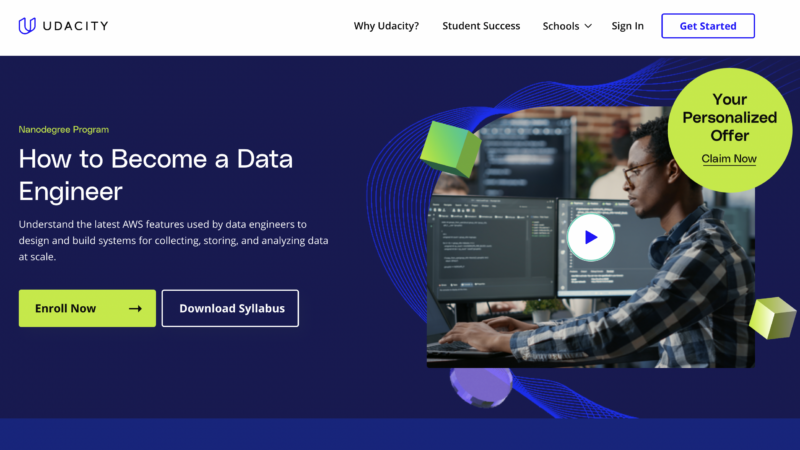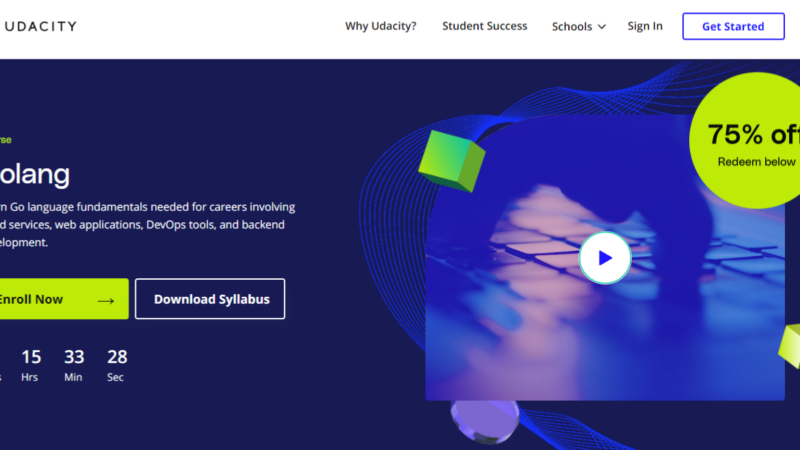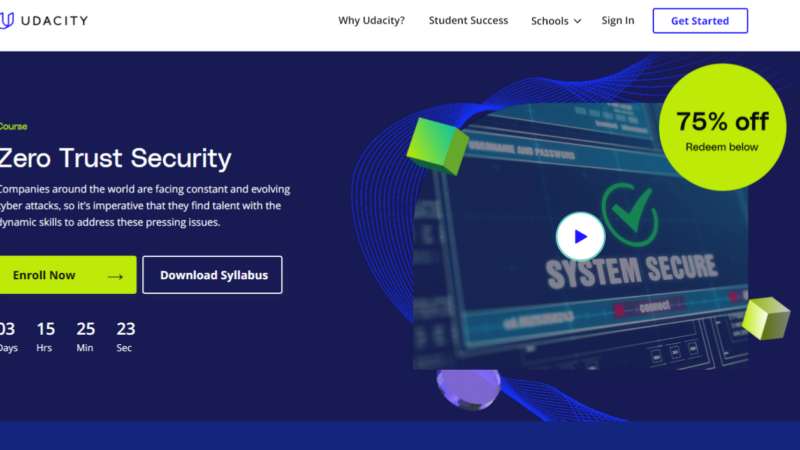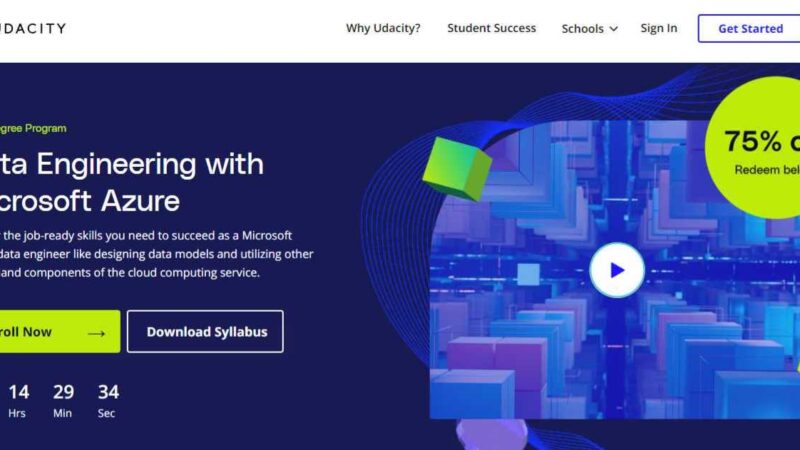Udacity Artificial Intelligence for Trading Nanodegree Review

AI is making its way into all kinds of markets. It’s ability to constantly shift based off of complex algorithms is key to creating some of today’s most used technologies. Combine the powers of pinpoint analysis, subtract the possibility of human error and you’ve got an equation that is a perfect fit for the stock market. Its unpredictable manner can now be tamed plus, come backed with a testable look into the future thanks to recent advancements in analysis methods and technologies.
Knowing the advanced methods and techniques available for in-depth analysis and tracking are an asset, especially when it comes to helping large companies and individuals secure their financial futures. If you’re part of the market and looking to amp up your skills, the Artificial Intelligence for Trading Nanodegree from Udacity can get you started. The course is meant to introduce you to advanced techniques plus, give your hands-on experience with projects. The academy has created this course in collaboration with World Quant, and we’re here with an inside look.
A Bit About Udacity
If you haven’t already heard of Udacity, it is an online academy that happens to have some killer connections. They weren’t always top-industry favorites, starting off humbly with the idea to bring free technological courses to all. The connections that they would make would eventually bring them to create certification courses that have the potential to land graduates a spot in the field. Now, you can find just about any topic in the world of IT plus, a long list of extras that are exclusively offered from the academy for anyone enrolled in a nanodegree.
Exclusive Udacity Extras
When you sign up for any nanodegree, you automatically score a few extras. These are meant to increase learner’s success, and are constantly upgraded to suit the requests of current and former students. These extras included in each nanodegree are:
Flexibility
When you sign up for any nanodegree, you’re able to learn when you want. With Udacity, you’re able to fit in your learning hours anytime of day, making a schedule that fits your busy life better.
Real Projects
The idea is to send graduates into the field with experience. This is why each nanodegree is embedded with different projects that give leaners hands-on experience working to solve real issues with techniques used by professionals in the field.
Community/Mentor
In case there are ever any technical difficulties, you’ll have a mentor to call. They are there to answer your questions at any time and will help to keep you on track. To get in some brainstorming time or just get social, you can strike up a chat with a fellow learner in the Udacity student’s forum.
Job Market Prep
Before sending you out into the real world, you’ll have a chance to let professionals help get you in tip top shape. They will help you perfect your resume, clean up your professional social pages and get a portfolio up and running for you. You can also schedule a mock interview to get constructive feedback on how you can shine among the competition.
A-List Instructors
Apart from the list of academy extras that come along with each nanodegree are the instructors. You will have experts in the field that have years of experience both as passionate instructors and industry leaders. Udacity really goes out of the way to put together an amazing team, making sure they fit each curriculum perfectly. For this course, the team of instructors includes:
Cindy Lin
Her skills as a quantitative analyst have landed her gigs with some of the top names in finance like Morgan Stanley and Merrill Lynch.
Arpan Chakraborty
After completing his PhD in Computer Science, Arpan took his passion for teaching into two forms, both as an instructor for Georgia Tech and coauthor of Practical Graph Mining with R.
Elizabeth Otto Hamel
As an expert in Applied Physics, Elizabeth studies the activity of neurons, mapping out patterns with analytical techniques.
Eddy Shyu
After receiving his MS in Financial Engineering, Eddy went on to work with companies like Morgan Stanley and BlackRock. Apart from his personal work, he leads learners at both Udacity and UC Berkeley.
Brok Bucholtz
His experience as a software engineer has landed him jobs with companies such as Optimal Blue. He is also builder and co-creator of several projects found within Udacity Deep Learning topics.
Parnian Barekatain
She is a self-taught programmer who has scored some killer internships along the way. Besides passing on her knowledge to other motivated learners, she takes the time to create programs to help self-learners of the future.
Prerequisites
Alright. This course is not for the newbie and comes with a long list of knowledge that you’ll need to bring with you. There is no time wasted at the beginning of the course, and it seems to just jump right in and begin. There are three areas in particular you should be familiar with, which are:
Python
- Some work with data structures
- NumPy
Statistics
- Understand mean, median, mode
- Standard deviation
- Random variables
- All types of distributions
- T-test, p-value
Calculus/Algebra
- Integrals and derivatives
- Linear concepts like combination and independence
- Matrix operations
If any of these prerequisites sounds a bit out of your skillset, you can opt for one of many free courses or introductory nanodegrees before jumping into this one. You can find a list of free courses here: https://blog.udacity.com/category/free-courses.
Course Breakdown
This course is meant to improve financial analysis techniques with the help of deep learning and Python. There are six sections, each one going one step further within the complex inner workings of today’s top techniques, the sections are:
Quantitative Training 101
In the first section, you’re introduced to all types of market mechanics, starting your crash course working with stock-data. At the end, you’ll work on creating your own system, working with momentum-trading.
Advanced your Technique
Right away, you’ll take what you learned and dive in a little deeper, learning more advanced techniques used in trading. You’ll work on building your own strategy at the end for your first project.
Stocks and Stuff
This section is all about the stocks. See how to enhance a portfolio and increase financial security with the help of stable stocks. You’ll learn about Indices and ETFs as well, using all this knowledge to help you optimize your first portfolio.
Factor Investing and More
In this section, you’ll work with Alpha plus, learn about how risk factors can be of assistance when building or bettering a portfolio. Using advanced techniques introduced in this section, you’ll do your own modeling using alpha research.
NLP and Sentiment Analysis
Using the methods of sentiment analysis and text processing, you’ll create your own analysis using NLP. See how this comes into play when creating trading signals.
Advance your NLP skills
Here is where you’ll get a glimpse into how deep learning can help in the creation of trading signals. These advanced quantitative analysis methods will help you to create a deep neural network with given data to apply what you’ve just learned.
Multiple Signals
See how pulling together multiple factors can help you paint a clearer picture. Using all sorts of data, you’ll combine signals in order to enhance alpha as an end of section project.
Simulating Trades / Historical Data
Running back tests and tracking P&L are emphasized in this section. This offers a deeper understanding of how your algorithm reacts as the market fluctuates. At the end, you’ll do your own backtesting, seeing how it all comes together to make the most informed decisions with help from advanced analytical technology.
The Time
Udacity claims that, on average, the course takes 6 months. This estimate is based off of dedicating 10 hours per week to the course and is, of course, only an estimate. With Udacity’s stand to be flexible, you can honestly take all the time you need, only needing to keep an eye out for due dates before totally procrastinating. You might also want to make sure not to take too long, with the price going up the more time you take.
The Cost
We know we probably caught your attention with that last line, which brings us to the cost of the course. The reason behind the estimated time is for the Udacity bundle deal, which is one of the two available payment options. Before we break those down, up and running on the site currently is a promo offer that you’ll want to score. The academy is now offering a free month of access, no matter which way you choose to pay.
Pay per month
With this option, you’ll be able to have access for as long as you want. Each month comes with the price of $359, so, it could add up if you’re taking your sweet time. However, if you’re ready to get in and get this course done, you could save money doing it this way.
Udacity Bundle Deal
Remember how we mentioned the estimated time? The reason for that is for the Udacity ‘bundle and save’ deal, where they charge one-time for the entire estimated time of completion. This way comes with a 15% cut on the total, where the cost per month comes to $258.
The Reviews
This course received a 4.5 out of 5 stars from current and former learners. The academy itself is known for positive vibes, with most who’ve had or thought about taking a course in awe. For a bit of an inside look into how the program went for actual students, here is what a few of them had to say.
“I loved the program. The first 3 projects were very basic, but everything after project 4 was great. You get introduced to alpha research, portfolio optimization and backtesting. In some of the projects you use Zipline, Quantopian’s open source library. While of course, it’s not expected for them to provide trading strategies to you, the applications of AI to trading seem relevant. You use neural networks, NLP, and random forests, among other models, in ways that are appliable to real trading research. Most of the instructors from Udacity do a very good job explaining the courses concepts, both theory and programming.” – Eduardo P.
“So far so good. I like especially the practice parts. I think it should be like 50% theory and 50% practice each in small iterations. There are other nanodegrees where in my opinion there is not enough practice. But for this nanodegree it is quite good in that regard.” – Thorbjorn T.
The Job Market
An analysis of the market conducted by Boston Consulting Group showed that the financial market will soon be affected by AI. Though this could be taken negatively, the analysis shows that, just like the evolution of other markets, the financial one will also follow in their footsteps. Economic Times showed that, those skilled with AI techniques are seeing an increase in both income and job availability.
When looking at the stock market, to be the most effective at trading, technology is a big help. Knowing how to create algorithms and deploy technological methods to monitor trends and patterns is the next big thing, and comes with the ability to earn your clients a lot of cash. Plus, it helps to map out more stable stocks, allowing you to take data and predict futures for added financial security.
The Take Away
AI is a good skill to have. It can be adopted into many practices in several markets, one of which is financial. Betting on the stock market can be a tricky and risky thing but, with help from technology and advanced analytical methods, you can confidently select and predict trends.
Udacity’s AI for Trading Nanodegree is meant to help you build a foundation for advanced practices and give you hands-on application opportunities before stepping out in the field. It could be just the thing, to launch you into a whole new way of trading.




